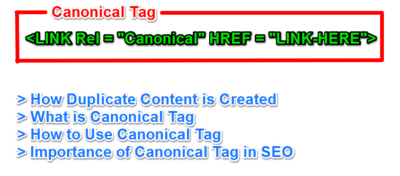We at Digiquads are on a mission to help 100 Businesses to boost their Online Sales by at least 30% in this Financial Year. Just wanted to know if it is Yours then mail us your requirement.
PS: Our eCommerce Division has seen some tremendous growth, so wanted to share the principles, methods, practices (and secrets) that you can use to skyrocket your eCommerce Business. If you have any query, do leave a comment on this blog or write us to hello@digiquads.com
Digiquads Mission Statement
Tags are the descriptive terms that you assign to an item which categorizes it. They can be found on websites, email-providers, and image-sharing portals.
Meta is “data about data”, thus the tags that provide such data are called meta tags.
There are several types of meta tags available and each meta tag has its own significance and use. In this article, we are talking about the canonical tag, how it looks like and how it works.
What is a Canonical Tag?
Canonical tags works on duplicate content and the preferred content. It is derived from the word “canon” which initially refers to biblical or secular laws. Later it was referred to as the works of a writer that were accepted as authentic.
It helps the search engines to identify which is the original page and which is the duplicate one.

Source: https://www.shoutmeloud.com/wp-content/uploads/2015/12/canonical-banner.jpg
Canonical tag is used when two identical piece of content exists on the internet. When such happens, then you should use this tag which contains the URL of the original published article.
This will then pass the PageRank to the original webpage and will inform the search engine that this page should appear in the search results.
How canonical tag look like?
Canonical tag will look like:
<link rel=”canonical” href=”https://digiquads.com/new/” />

Source: http://www.seosuccesstips.com/wp-content/uploads/2015/08/Canonical-Tag-in-SEO.png
How to apply the Canonical Tag?
For Google to recognize the pages as canonical, you need to add a link tag to the head of the HTML code.
The element with the attribute rel = “canonical” must be added to the <head> section of these pages. It should be given the absolute URL (with domain), not only the relative URL.

Source: http://www.mitasys.com/wp-content/uploads/2016/02/Canonical-Tag-Image-1024×414.png
What is the Importance of a Canonical Tag?
Using duplicate content is a big no to the search engines. If your website is using duplicate content or the content which is similar then Google might devalue your website when defining rankings. A content management system like WordPress or Drupal must be utilized if you are using an HTTP on your website. By using proper canonical tags at proper places, you can avoid the pitfall condition and you can take advantage of both a complete site and streamlines the Search Engine Optimisation practices.
So, the canonical tag is important for:
- eliminating the duplicate content issues
- passing link authority between your ages more effectively
- help search engines crawl your site more effectively
- Ultimately, leading to higher rankings
Since there are many instances having similar content, so one must put a tag on as many pages as possible.
Also, to implement a canonical tag, you must ensure it’s correct or else it leads to big issues.
When Should You Use Canonical Tags?
URL Parameters
It is often ignored but it is very important to look at it as an important element. This parameter is created for the purpose of tracking which will help you in tracking campaign performance to certain objectives of the attribute URLs. The basic problem is that each and every parameter which is created to the main URL convey to search engines that the created ones are duplicate versions of the page. This will end up lowering down the effect of SEO. The issue can be combat by the recognition of the main page as canonical page.
Self-referential
It was highly debatable topic when it was announced by the Google that self-referencing canonicals should always be used. It means that adding of canonical tag to every page is must. It is so important that it doesn’t matter whether it is duplicate or not. This will also help to reach your URL when there are multiple ways. For example you have www.xyz.com, anybody can reach your site through http://xyz.com or http://xyz.com, and so on. Now, if you add canonical tag to these it will let search engine recognize it is just the same and one page. Along with it, one should index it and it is going to show the result.
Region or Country Specific URLs
Geotargeting is also one of the another way to target your audience which is based upon where they are residing. You can do this by adding a regional slug or by the usage of regional subdomain. You need to ensure that these regional specific domains are pointing back to the main version of the site or page. You will have to include canonical tag on most of the same content when it is region specific and in the same language. You need to look upon this criterion carefully.
Having duplicate content poses a penalty and it affects the relevancy of the results which in turn will affect your page rank which is directly affecting your site’s traffic and revenue as well. Though, canonical tags won’t automatically improve your site’s visibility but will surely affect your rank.
Thus, knowledge of canonical tags is important plus how you can apply this tag is also very important as it will help you with the Google page rankings and most importantly will explain to you it needs that do you have a duplicate content or have multiple URLs pointing towards the same content.

